#Sensu
Photo
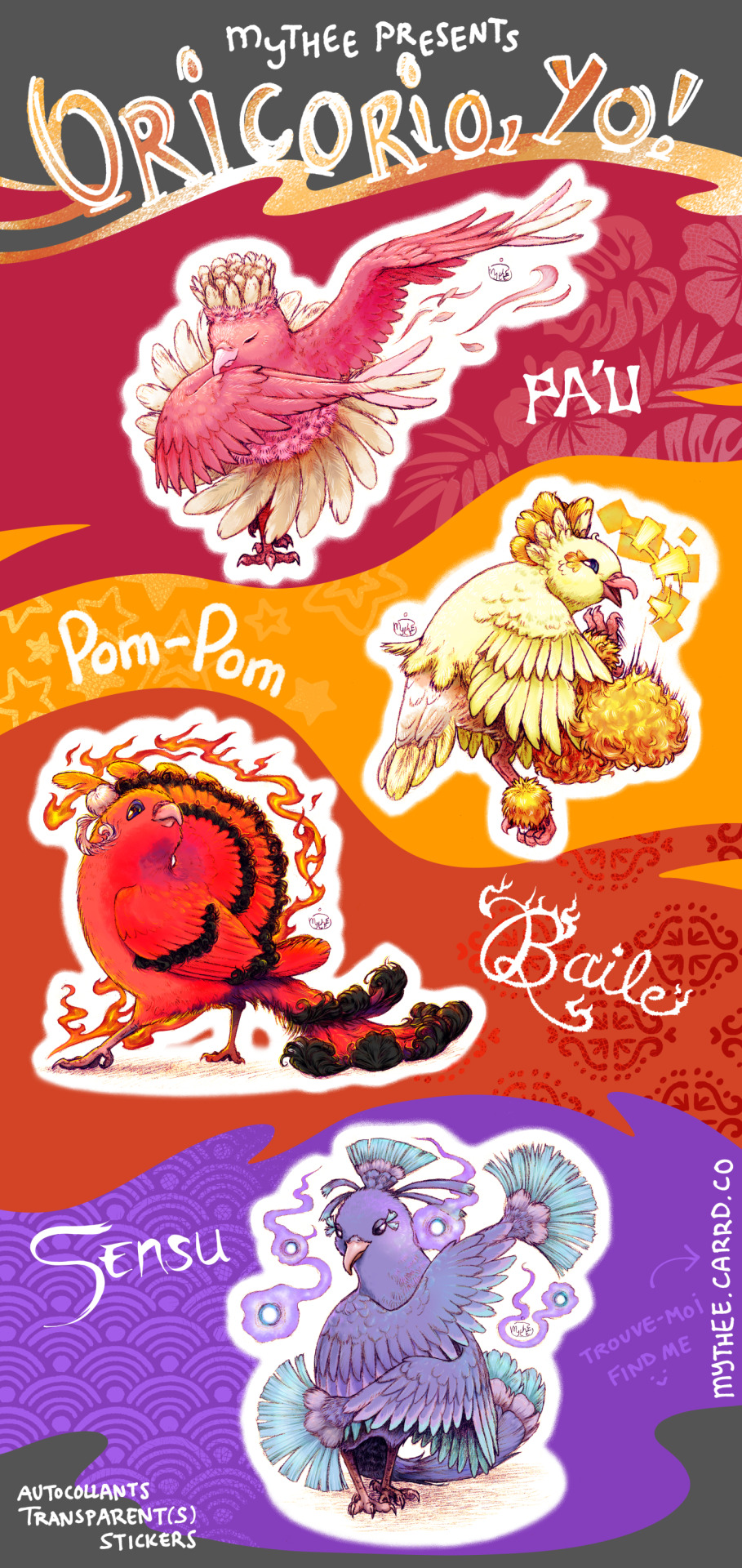
Oricorio has one of my favorite pokemon designs! I made this sticker sheet for boothing at Nadeshicon. You can read up ojn the process here!
By the shore, I greet the day
With undulating, gentle sway.
A grassy field is the best place
To bounce and flip and about-face!
Onstage, with heat and passion
I stamp my feet and flare my fashion.
In petal’s shadow, in garden’s lace
I slowly dance with spooky grace.
-Mythee
286 notes
·
View notes
Photo


Types of ôgi (folding fans), handy reference chart by Edo-era lover Nadeshico Rin. Please note this overview doesn’t cover all Japanese fan variations, for example also see maiôgi (舞扇 dance fan), tsunenoôgi (常の扇 common fan), shizume (鎮扇 noh fan), rokkoku (六骨 Kamakura fan), gunsen (軍扇 war fan), etc etc.
Fans were first imported to Japan from China, and were used from the start as symbols of status and refinement. Chinese fans were originaly rigid ones (see modern uchiwa), and according to Rin, foldable ones appeared in Japan during Heian period free from Chinese influences.
In the past, word ôgi 扇 meant “sliding door” (today 戸板 toita), and overtime lost its original meaning to only designate folding fans.
From right to left, you can see on first picture the oldest known Japanese folding fans:
Hiôgi (檜扇 - ひおうぎ) - hinoki cypress fan, used by Heian nobles. Some theorise those were first made from shaku 笏 (a type of ritual wooden baton used in Shinto) hold together by threads. Hiôgi were symbol of power and formal ones were heavily decorated with painted sceneries and dangling colorful ribbons.
Kawahori (蝙蝠 - かわほり) - lit. «bat» fan, appeared around mid. Heian period. Those were simplified hiôgi meant to be used in Summer. The lighter frame had paper pasted on one side, somehow giving the aspect of a bat wing when seen from reverse.
From there, kawahori fans morphed during Muromachi period:
Ukeori (浮折 - うけおり) or «floating» types which had unmovable handles and looser top parts. Some examples are:
- Suehiro (末広 - すえひろ) - spread out fan, with curving ribs
- Chûkei (中啓 - ちゅうけい) - ceremonial fan, used by nobles, samurai and monks
- Bonbori (ぼんぼり) - the little brother of the chûkei which appeared during Edo period (bonbori are paper covered lanterns I don’t know if those and this fan are linked).
Shizumeori (沈折 - しずめおり) or folding types, where whole structure can be collapsed, looking quite sleek and refined. Most known fan of this type is:
- Sensu (扇子- せんす) - folding fan, which is the most spread nowadays. During Muromachi period, paper began to be put on both sides, hiding the ribs. Interestingly, Imperial court still favors one side paper only even today as a nod to the original design.
During Edo period, folding fans use spread among the whole population and their ribs started to get more and more decorated with sukashi (透かし openwork). Some popular designs included:
Hanabishi (花菱 - はなびし) - flowery diamond-shaped cut-out
Nekomasukashi (猫間透し - ねこますかし) - «cat door» cut-out (sometimes also called nekome/猫目/cateye)
Kamatarisukashi (鎌足透し - かまたりすかし) - «heels apart» cut-out
Oosukashi (大透し - おおすかし) - big cut-out
Rokkotsusukashi (六骨透し - ろつこつすかし) - «six points» cut-out
Chôjisukashi (丁子透し - ちょうじすかし) - «clove» cut-out
Nagachôjisukashi (長丁子透し - ながちょうじすかし) -«long clove» cut-out
#japan#fashion history#history#Nadeshiko Rin#fan#folding fan#hand fan#ogi#ougi#Sensu#hiogi#kawahori#Suehiro#Chukei#Bonbori#sukashi#cut-out#references#ressources#Edo period#heian period
341 notes
·
View notes
Text
Kanzashi of The Month: January - 2023′s Design
On The Twelfth Day Of Fun I present... this year’s kanzashi! Thank you to everyone who’s been following along with the features this year! If I didn’t get to your ask during TTDOF then please know that I still may have it kicking around and will get to it eventually. For now, let’s look at what 2023′s bringing us!
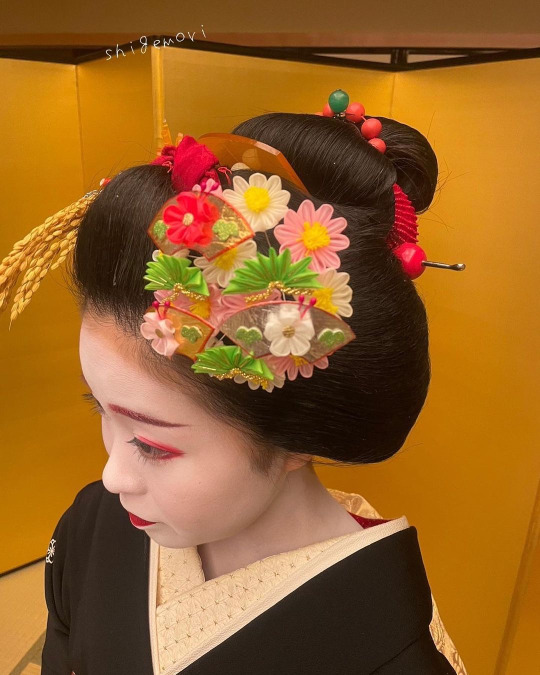
Image courtesy of Shigemori.
Sensu (扇子) - Folding Fans
Matsu (松) - Pine
Kangiku (寒菊) - Winter Chrysanthemum
This year’s kanzashi has a nice, classic look to it with shiny folding fans accented with bright green pine! It’s cute to notice that the plum blossoms on the middle of the fans cover each color that plum blossoms bloom in (white, pink, and red) and don’t repeat. The pine makes a very bold and masculine statement to balance out the very feminine folding fans and plum blossoms, giving it a yin yang feel. As usual, we have kangiku acting as a base, with pink and white being used for senior maiko, like Fukusono above.
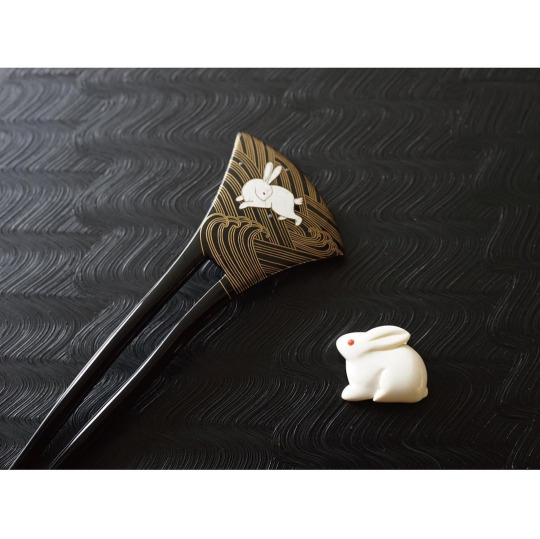
Image courtesy of Kazurasei.
2023 just happens to be the Year of The Rabbit in the Asian zodiac! Known for being the luckiest of the twelve animals, rabbits are also blessed with intellect and charm. In Japanese mythology it is said that a rabbit resides on the moon pounding mochi (rice cakes). There’s an interesting story of how the rabbit got on the moon in the first place:
One day the king of the gods came through the forest disguised as a beggar. Various animals all came to offer the beggar something to eat, but the rabbit could only provide grass. In an act of self sacrifice, the rabbit threw itself onto a fire to cook itself for the beggar. The king, recognizing the rabbit’s sacrifice, placed the rabbit on the moon for all to see and thus the rabbit now lives on the moon ^^
#maiko#geiko#geisha#kyoto#kanzashi#2023#folding fans#sensu#matsu#pine#kangiku#winter chrysanthemum#舞妓#芸妓#芸者#京都#かんざし#簪#扇子#松#寒菊
59 notes
·
View notes
Text






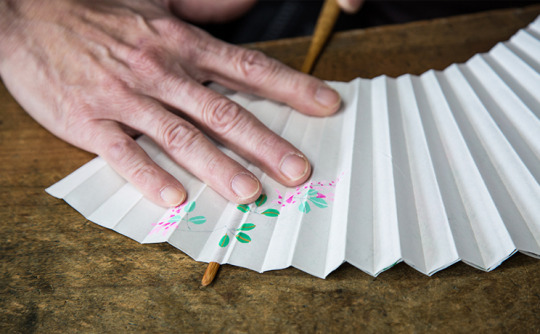

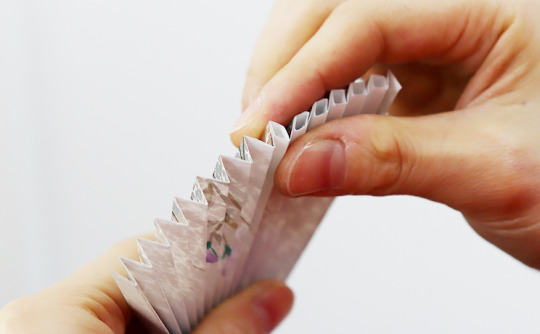




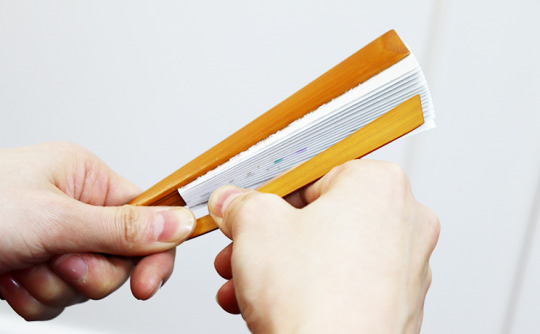
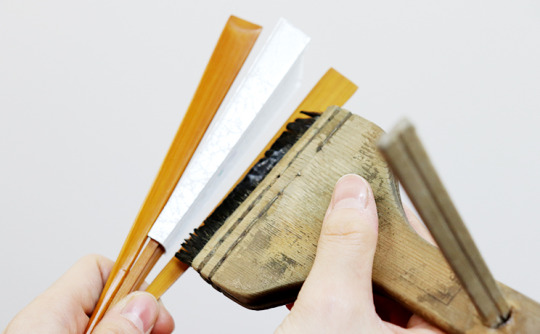

folding fans are said to undergo approximately 88 steps from cutting bamboo to completion, and they are crafted by the hands of multiple artisans.
The processes of crafting the frame, paper, painting, and finishing are all specialized tasks.
For the creation of the original fan, we entrusted the renowned Kyoto folding fan shop, Hakutiku-do, to produce a custom-made folding fan.
The material that forms the core of the folding fan's structure utilizes young bamboo aged between 3 to 5 years. It is delicately processed into thin pieces, starting the intricate carving and painting stages.
The paper for the fan surface is created by cutting three layers of paper with a core in between, sandwiched with washi paper, into the shape of a folding fan.
While typically, each piece of cut paper is individually painted by an artist, the original fan employs paper printed with Hidenobu Suzuki designated colors and arrangement. Subsequently, the printed paper is folded in an accordion-like fashion.
Using two molded templates with grooves, the folded paper is sandwiched between them, and one or two creases are applied, creating pathways for inserting the ribs in the later stages of finishing.
In the final finishing stage, air is blown into the section where the creased paper accommodates the inner ribs, creating holes.
The inner ribs, coated with water-based glue, are then inserted and adhered.
The thicker ribs on both sides, known as the "parent ribs," are heated, bent inward, and glued to the paper, shaping and refining the fan's form.
Thus, an original folding fan is meticulously brought to life through these steps.
Would you like to buy a folding fan that is a traditional Japanese craft?
You will be very satisfied with the beautiful finish.
HIDENOBU SUZUKI PHOTOGRAPHY SHOP
扇子は竹をきるところから仕上げまで約88工程あると言われ、何人もの職人たちの手によって作られています。
骨づくり、紙、上絵、仕上げ、それぞれが分業になっています。
オリジナル扇子制作にあたって、京扇子の名店、白竹堂さんにお願いをしてオリジナル扇子を製作して頂きました。
センスの骨になる材料は、3年から5年の若い竹を使い、薄く細かく加工して細工や塗工程から製作が始まります。
扇面の紙は、芯紙を表と裏から皮紙で挟んだ3枚合わせのものを使用して扇の形に切り抜いていきます。
通常は、切り抜いた紙に絵師が1枚1枚上絵を付けていくのですが、オリジナル扇子は、鈴木秀総の作品を指定した色と配置でプリントした紙を使用しています。
その後、プリントが終わった紙を蛇腹状に折る作業を行います。
渋引きをした型紙2枚で紙を上下から挟み、1枚もしくは2枚ずつ折り目をつけ、後の仕上げ工程で骨を差し込む道を通していきます。
最後の仕上げ工程では、折り目をつけた紙の仲骨が通る部分に息を吹き込み穴を開け、水糊をつけた仲骨を差し込み接着します。
親骨とよばれる両側の太い骨は熱して内側に曲げて紙を接着し、形を整えて仕上げていきます。
こうして1本のオリジナル扇子ができるのです。
#photography#japan#hidenobu suzuki#cooljapan#art#photograph#folding fan#sensu#traditional Japanese craft#traditional#traditional art#kyoto
8 notes
·
View notes
Photo

Grook's Flower Crown
Grooky found a new friend! a baby Oricorio! Flowers crowns are the perfect way to celebrate a new friendship~!
You can find other websites to follow me on here -> https://linktr.ee/allyclaw
Like my art? Leave a tip -> https://ko-fi.com/allyclaw
Posted using PostyBirb
#Pokemon#gooky#pokemon day#poke#monkey#bird#Oricorio#Sensu style#sensu#sword and shield#flower#flower crown#cute#grass type#grass#gen 8#generation 8#gen VIII#starter#starter pokemon#adorable#sitting
18 notes
·
View notes
Photo

Japanese Fans (Sensu).
19 notes
·
View notes
Photo

#huuzin#sensu#fan#kimono#japan#portrait#kimonofashion#meisen#antiquekimono#ポートレート#風神の扇子#銘仙#モダン銘仙コーデ#アンティーク着物#着物女子#札幌着物#粋
5 notes
·
View notes
Text
GROWING - NOVA

What's this? One of our Pokemon has grown! Nova from user Thaliawen has grown from a pokemon to a child! Thanks to artist Mewmouse for drawing her into a child!
#gijinka#pokemon#pokemon gijinka#pokemon oc#roleplay#roleplaying#rp#jirachis wish#sensu#oricorio#growing
1 note
·
View note
Text

moss piglet
#scribbles#tardigrade#water bear#moss piglet#bug doodles#reminder you can pay me $5 on kofi to draw a bug for you#'bug' sensu lato#btw i am actually working on some higher-effort drawings but still mostly in my lazy digital scribbles phase#bflyart
3K notes
·
View notes
Text
HA Proxy Multiple Sockets
HA Proxy Multiple Sockets
Problem
You are leveraging HA Proxy and need to monitor it closely to ensure good performance for your site or service. In most cases, this will mean monitoring. In my case, I leveraged telegraf and sensu for monitoring the socket.
However I ran into permission problems trying to have both sensu and telegraf use the same user/group to read the stats. I got the below error.
This file contains…

View On WordPress
#haproxy#haproxy cfg#haproxy configuration#haproxy stats#http#sensu#sensu check#socket#stat#stats enable#telegraf
0 notes
Text
How to Install Sensu GO Monitoring Tool on Ubuntu

If you're looking for a way to monitor your infrastructure and applications, you may want to consider using Sensu.
In this blog post, we'll take a look at what Sensu is, how it works, and some of its key features.
This tutorial will be helpful for beginners to install Sensu Go Monitoring Tool on Ubuntu 22.04 LTS and Ubuntu 20.04
What is Sensu Go?
Sensu Go is an open-source project that aims to provide a simple, scalable monitoring solution for modern cloud environments. Sensu Go is built on top of the Sensu monitoring framework and includes a new data model, APIs, and web UI.
Sensu Go is designed to be used in conjunction with other tools in the Sensu ecosystem, such as the Sensu agent and Sensu backend. Sensu Go can also be used as a standalone monitoring solution.
Sensu Go Architecture

Sensu Go has 2 main components
- Sensu Backend
- Sensu Agent
Sensu Agent
Sensu Agents are lightweight clients that will run on the infrastructure that needs to be monitored. Agents are responsible for sending the Metric events and creating status to the Sensu backend.
Sensu Backend
It is the Core of Sensu Architecture and it contains Web UI, HTTP API, WebSocket API, and embedded etcd store.
Web UI - Web Based UI used for managing and creating entities, Checks, handlers, etc.
embedded etcd store - Contains all the event data.
HTTP API - Used by Sensuctl and Web UI
Install SensuGO On Ubuntu 22.04 LTS / 20.04 LTS
Step 1: Make sure the system is up to date
sudo apt update && sudo apt upgrade -y
Step 2: Install Sensu Backend
Add the Sensu repository to the system and install the sensu go backend package.
curl -s https://packagecloud.io/install/repositories/sensu/stable/script.deb.sh | sudo bash
sudo apt install sensu-go-backend
Step 3: Configure and start the Sensu Backend
Copy the config template from the sensu docs and move it to the/etc/sensu directory
sudo curl -L https://docs.sensu.io/sensu-go/latest/files/backend.yml -o /etc/sensu/backend.yml
Start the Sensu Backend service
sudo systemctl start sensu-backend
sudo systemctl enable sensu-backend
sudo systemctl status sensu-backend
Step 4: Configure the Username and password for the Sensu Web UI
The next step is to generate the admin username and password to access the Sensu web UI
sensuctl-backend init --interactive
Step 5: Access Sensu Dashboard
Now, open your browser and access the Sensu dashboard using the URL
http://:3000

Setup Sensuctl
A command-line tool called Sensuctl is used to manage resources with Sensu. Sensuctl tool is available for Linux, Windows, and macOS.
For installation add the Sensu repository and install the Sensu go package
curl -s https://packagecloud.io/install/repositories/sensu/stable/script.deb.sh | sudo bash
sudo apt-get install sensu-go-cli
Once installtion completed, configure using the below command
sensuctl configure -n --username 'YOUR_USERNAME' --password 'YOUR_PASSWORD' --namespace default --url 'http://127.0.0.1:8080'
Install Sensu agent
In my setup i have installed and configured my Alamlinux server as sensu agent.
Step 6: Add the repository and install sensu agent
curl -s https://packagecloud.io/install/repositories/sensu/stable/script.rpm.sh | sudo bash
sudo yum install sensu-go-agent
Step 7: Configure the sensu agent by replacing your ip address in the below template and start the service.
cat /etc/sensu/agent.yml
---
namespace : default
backend-url:
- "ws://ipaddress:8081"
EOF
Step 8: Start the Sensu agent service
systemctl start sensu-agent
systemctl enable sensu-agent
Step 9: Verify the agents are communicating or not
Login to the web UI and navigate to the Entities tab to check the server is reflecting or not, if the server is listed, the agent is communicating.

Reference : Install Sensu Go
Conclusion
From this tutorial, you have learned how to install Sensu GO Monitoring Tool on Ubuntu
Do let us know your comments and feedback in the comments section below.
If my articles on TipsonUNIX have helped you, kindly consider buying me a coffee as a token of appreciation

Thank You for your support!!
Read the full article
0 notes
Photo

0 notes
Photo

#sensu #扇子 (at Mill Creek Nature Preserve) https://www.instagram.com/p/CiF7ASJPjfd-1RgCVtn8yjlal9GaG4nYY_xWNw0/?igshid=NGJjMDIxMWI=
0 notes
Text
Our Story
In recent years, the number of natural disasters has been increasing all over the world.
Global warming is thought to be one of the causes.
Considering the effects of global warming, it is important to raise awareness of keeping the temperature down by using fans that are made from eco-friendly natural materials.
We believe that by increasing the number of people who are aware of global warming, we can contribute to the mitigation of global warming, even if it is just a small effort.
When I thought about what I could do, I came up with a project that fuses traditional folding fans with modern digital photography.
This is a combination of ancient traditions and contemporary artistic expression, resulting in innovative works of art, aiming to evoke feelings of appreciation and appreciation for the earth through folding fans.
Beautiful images captured with digital photography are a visual reminder of the beauty of nature and the importance of sustainability. By blending traditional craftsmanship with modern creativity, I believe this project can evoke a universal understanding and passion for protecting the planet.
Our ultimate goal is to spread this project around the world and to evoke the sympathy of people from all walks of life.
Reminiscent of the shape of an ogi, our sense of responsibility for the environment will ripple through, hoping that the impact of this project will spread far and wide, inspiring people to become advocates for positive change.
HIDENOBU SUZUKI
Our Story
近年世界中で自然災害が増え続けています。
その一つの原因として地球温暖化が考えられています。
地球温暖化の影響を考慮して、環境に優しい天然素材を使用した扇子を使用することで、気温を抑える意識を高めることが大切です。
温暖化を意識する人の数を増やすことで、たとえ小さな取り組みであっても、地球温暖化の緩和に貢献することに繋がると考えています。
私が出来ることを考えた時に、私は伝統的な扇子と現代のデジタル写真を融合するプロジェクトを考えました。
これは、古くからの伝統と現代の芸術表現の組み合わせにより、革新的な芸術作品が生まれ、 扇子を通じて、地球を大切にし感謝の気持ちを呼び起こすことを目指しています。
デジタル写真で撮影された美しい画像は、自然の美しさと持続可能性の重要性を視覚的に思い出させてくれます。私は、このプロジェクトが伝統的な職人技と現代の創造性を融合することによって、地球を守ることに対する普遍的な理解と情熱を呼び起こすことができると信じています。
私たちの最終的な目標は、このプロジェクトが世界中に広がり、さまざまな立場の人々の共感をよぶことです。
おうぎの形を連想するように、私たちの環境に対する責任感が波紋のように広がり、このプロジェクトの影響が広範囲に広がり、人々の心を動かし、前向きな変化の支持者となるよう促すことを願っています。
HIDENOBU SUZUKI
2 notes
·
View notes
Text
Czasami mam ochotę po prostu krzyknąć: Pierdolcie się kurwa wszyscy!
I odejść.
#blog z cytatami#cytaty#zły dzień#złamane serce#zmęczona życiem#zmęczenie#brak chęci do życia#brak nadziei#samotność#introwertyk#polski cytat#bez sensu
271 notes
·
View notes
Photo

My Neighbour Totoro Folding Fan ~ Summer Night-Time
#Japan#Folding Fans#My Neighbor Totoro#Summer#My Neighbour Totoro#Sensu#Ogi#Studio Ghibli#Hayao Miyazaki#Nippon
3 notes
·
View notes